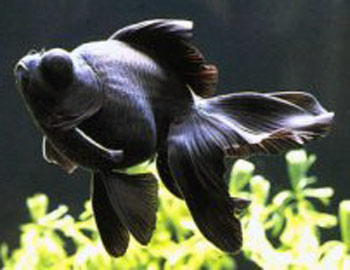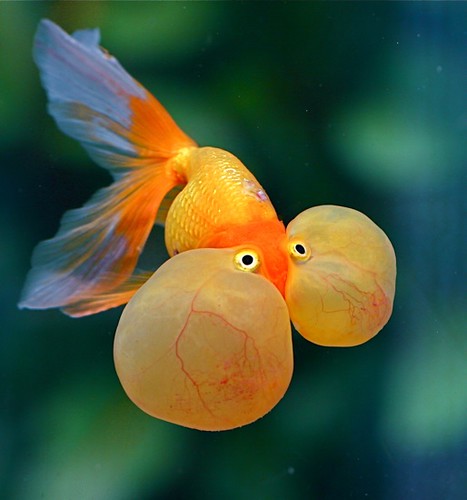Almost every aquarium contains goldfish. Who would not love this lovely, bright colored fish inside their tanks? Undoubtedly, the goldfish is one of the most commonly kept aquarium fish and is also one of the earliest domesticated fish. Scientifically known as Carassius auratus auratus, it is a small member of the carp family, related to koi and crucian carp, which was first domesticated in China more than a thousand years ago. Since then, several distinct breeds have been developed which varied the colors of this fish (not only the “golden” color), body shape, fin, and eye configurations. Here are ten of the best domesticated varieties of goldfish.
Oranda
The oranda is one of the most popular goldfish. It is known for its raspberry-like hood or headgrowth, also called as wen, which encases the whole head except for the eyes and mouth. Sometimes the wen grows enormously that it covers the eye, limiting the vision of the fish and even blinding others. The wen is also prone to bacterial infection so proper care of the fish must be practiced. The oranda also has a large, long and deep body with four-lobed tail. It can reach 8 to 12 inches in length. The orandas come in many colors, most often orange, red, red-and-white, red-and-black, black, blue, chocolate, bronze, white, or silver, black-and-white, red-black-and-white, and calico colors.
Ryukin
 The ryukin is a short deep-bodied fancy goldfish with a pointed head and pronounced hump on the back behind the head. Its fins may be short or long with either a triple or quadruple tail. This fish can reach up to a length of 8 inches. The ryukins come in deep-red, red-and-white, white, iron, and calico coloration.
The ryukin is a short deep-bodied fancy goldfish with a pointed head and pronounced hump on the back behind the head. Its fins may be short or long with either a triple or quadruple tail. This fish can reach up to a length of 8 inches. The ryukins come in deep-red, red-and-white, white, iron, and calico coloration.Black moor
 The black moor belongs to the telescope-eyed breed of fancy goldfish that has projecting eyes. It has deep bodies and long, flowing finnage. It can grow up to a length of 10 inches. The black types of this can revert to metallic orange when exposed to warm water temperature. The black moor is a hardy fish and can withstand a wide variety of temperatures and live with other fishes. This fish is also known as popeye, telescope, kuro demekin in Japan, and dragon-eye in China.
The black moor belongs to the telescope-eyed breed of fancy goldfish that has projecting eyes. It has deep bodies and long, flowing finnage. It can grow up to a length of 10 inches. The black types of this can revert to metallic orange when exposed to warm water temperature. The black moor is a hardy fish and can withstand a wide variety of temperatures and live with other fishes. This fish is also known as popeye, telescope, kuro demekin in Japan, and dragon-eye in China.Ranchu
 The Japanese considers this fish as the “king of goldfish.” Resulting from the direct crossbreeding of different Chinese lionhead species, the ranchu has rounded arched back and short fins. It has egg-shaped body with a deep belly and has no dorsal fins. The striking feature of this fish is its head. It has sufficient space between the eyes, and also from the eyes to the front of the head. The ranchus come in many colors like orange, red, white, red-and-white, blue, black, black-and-white, black-and-red, and even pale yellow which is rare. Its scale may also be metallic, nacreous, or matte.
The Japanese considers this fish as the “king of goldfish.” Resulting from the direct crossbreeding of different Chinese lionhead species, the ranchu has rounded arched back and short fins. It has egg-shaped body with a deep belly and has no dorsal fins. The striking feature of this fish is its head. It has sufficient space between the eyes, and also from the eyes to the front of the head. The ranchus come in many colors like orange, red, white, red-and-white, blue, black, black-and-white, black-and-red, and even pale yellow which is rare. Its scale may also be metallic, nacreous, or matte.Pearlscale
 As its name suggests, the pearlscale or chinsurin in Japanese has thick, domed scales which look like pearls. It has a spherical body similar to a golf ball. Its body can be as short as 2 ¼ inches and as long as 8 inches. Moreover, the pearlscale can grow as large as an orange. Since the fish has a compact body, overfeeding it must be strictly avoided. They are also very sensitive to cold water and to long periods of exposure to high acidity and alkalinity.
As its name suggests, the pearlscale or chinsurin in Japanese has thick, domed scales which look like pearls. It has a spherical body similar to a golf ball. Its body can be as short as 2 ¼ inches and as long as 8 inches. Moreover, the pearlscale can grow as large as an orange. Since the fish has a compact body, overfeeding it must be strictly avoided. They are also very sensitive to cold water and to long periods of exposure to high acidity and alkalinity.Bubble eye
Also referred to as suihogan in Japan, the bubble eye has an evenly curved finless back. The most prominent feature of this fish is the presence of large pouches of skin attached below its upward pointing eyes. These eye bubbles are fluid-filled sacs that normally match the color and size of the fish. Having metallic scales, the bubbles shake as the fish swims. They only develop when the fish is three months old after hatching. However, these eye bladders are fragile so the bubble eye must be separated from wild fishes and from sharp decors, although the bubbles will regrow when punctured.
Veiltail
 The veiltail is known for its extra-long, flowing double tail which is square-edged and without any indentation between the lobes. It has a body similar to the ryukin but without the dorsal “hump” typical of ryukins. Its anal fins are paired and well-developed. This goldfish comes in a variety of colors and may have either metallic or nacreous scales. The veiltail can grow from 8 to 12 inches.
The veiltail is known for its extra-long, flowing double tail which is square-edged and without any indentation between the lobes. It has a body similar to the ryukin but without the dorsal “hump” typical of ryukins. Its anal fins are paired and well-developed. This goldfish comes in a variety of colors and may have either metallic or nacreous scales. The veiltail can grow from 8 to 12 inches.Butterfly Tail
 Otherwise known as the butterfly telescope, it is a variety of goldfish popular for its butterfly-shaped caudal fins when viewed from above. Its tail can spread as wide as 180 degrees but some may droop down as a result of its weight. It is a variant of the telescope eye goldfish and like other fish in this family, the butterfly tail also has protruding eyes.
Otherwise known as the butterfly telescope, it is a variety of goldfish popular for its butterfly-shaped caudal fins when viewed from above. Its tail can spread as wide as 180 degrees but some may droop down as a result of its weight. It is a variant of the telescope eye goldfish and like other fish in this family, the butterfly tail also has protruding eyes.Shubunkin
 The shubunkin is a cross between Calico telescope eyes and common goldfish, and is of Japanese origin. This is a hardy, single-tailed fancy goldfish with nacreous scale. It has a pattern called as calico, an overlapping of red, white, blue, grey and black (along with dark speckles) colors. The shunbunkins can reach a length of 9 to 16 inches.
The shubunkin is a cross between Calico telescope eyes and common goldfish, and is of Japanese origin. This is a hardy, single-tailed fancy goldfish with nacreous scale. It has a pattern called as calico, an overlapping of red, white, blue, grey and black (along with dark speckles) colors. The shunbunkins can reach a length of 9 to 16 inches.Panda Moor
 The panda moor is a variety of moor goldfish which can grow very fat. It typically has delicate protruding eyes, deep bodies, and long flowing fins in black-and-white color pattern. With their metallic scales, pandas have velvety appearance in maturity which decreases as it ages. This fish only thrives in cool water.
The panda moor is a variety of moor goldfish which can grow very fat. It typically has delicate protruding eyes, deep bodies, and long flowing fins in black-and-white color pattern. With their metallic scales, pandas have velvety appearance in maturity which decreases as it ages. This fish only thrives in cool water.See what others have to say on "Ten Beautiful Breeds of Goldfish".


This comment has been removed by the author.
ReplyDeleteAll of them are really beautiful.Those who love pets can take help form this list to know about their next probable pets. You people can take help from Pet Grooming Tips to take proper care of your pets and know how to take proper care of them so that they can live longer.
ReplyDeletevery true goldfish fatcs
ReplyDeleteThese are some of the very useful information. very interesting and so good to read.
ReplyDeleteBangalore Cabs
Thanks for your blog.
ReplyDeleteBike Rental Service in Goa
Nice Blog.
ReplyDeleteBike Rental in Goa Airport
Thanks for your post.
ReplyDeleteSelf Drive Cars in Goa
Excellent your blog . your information is very informative Thanks for sharing this nice information
ReplyDeleteyou can get accounting software service at quickbooks customer service number
Thank a lot for this post that was very interesting. Keep posting like those amazing posts, this is really awesome :)
ReplyDeleteLooking For Car Rental Goa, Visit
Car On Rent in Goa
Thank a lot for this post that was very interesting. Keep posting like those amazing posts, this is really awesome :)
ReplyDeleteLooking For Car Rental Goa, Visit
Car Rent in Goa